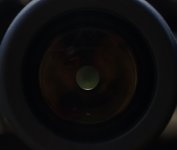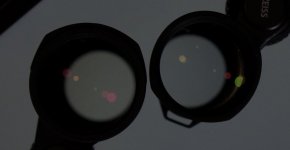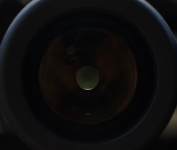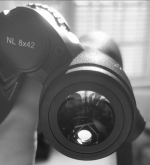henry link
Well-known member
I recently had the opportunity to do a few quick tests of a local dealer's newly arrived Zeiss 8x40 SFL. Here are the results.
Distortion:
I brought along my usual target of small circles to test for angular magnification distortion as well as a grid pattern I view backwards through the objective lens to evaluate the rectilinear distortion. The left photo below shows moderate AMD distorting the circles as they approach the field edge on the right side of the image. BTW, the bright green at the field edge is sunlit leaves behind the target, not a binocular artifact.
The grid pattern (not photographed) showed moderately low pincushion with just a hint of a "mustache" reversal at about 6-8 degrees from the field edge. Overall a nicely managed distortion profile with a very low potential for panning disturbances like "rolling ball".
Off-axis Aberrations:
The distortion photo also inadvertently demonstrates to some extent the behavior of the off-axis aberrations of field curvature, astigmatism and lateral color. Notice how the circles near the edge are better focused along the axis between 9:00 and 3:00 than between 12:00 and 6:00. that's an indication of astigmatism and the color fringes of lateral color can also be seen running along the black lines of the circles. I also used an astigmatism target consisting of thin horizontal and vertical lines (not photographed). When the lines are placed at 6:00 on the field edge both will be simultaneously focused only if there is no astigmatism. In the presence of astigmatism only one set of lines at a time can be focused. To determine field curvature I find the midpoint between the two foci and compare it to the center focus point. Unlike some field flatteners that correct astigmatism much better than field curvature the field flattener of the SFL appears to leave about equal amounts of astigmatism and field curvature uncorrected, I would guess about 1.5-2 diopters of each. The best field flatteners leave only a small fraction of a diopter of each uncorrected. Lateral color begins at about 6-8º off-axis, but remains pretty low all the way to the edge. Overall I would call the off-axis corrections good to very good for astigmatism and field curvature and very good for lateral color.
Glare:
The next photo shows an internal reflection near the objective lens cell when the binocular was pointed toward a dark area of foliage below a bright sun about 40º above the binocular's line of sight. That lighting condition created a large bright area of veiling glare in the bottom half of the FOV. I expect there will be differences of opinion about glare in this binocular because this is a worst case example and the veiling could be essentially eliminated for me by simply adjusting the eyecup one step in from fully extended. I think most people will be able to find an eyecup length that works with their face to eliminate the glare, but perhaps a few won't.
Color Transmission:
Unfortunately the dealer had no SF models in stock, so I compared the color bias of the SFL to a Conquest 8x42. The photo below shows the view through the objective lenses of the Conquest and the SFL when placed eyepieces down on top of an iPad with a blank white screen. I hope it's obvious that the color transmission of the SFL comes much closer to matching the background color of the screen than the Conquest does.
Axial Aberrations and defects:
I used a Zeiss Tripler for an artificial star-test (Christmas tree ornament in the sun), which gave a magnification of 24x, about half as much as I would prefer for a star-test of a 40mm lens. The physical shortness of the SFL led me to be suspicious that both spherical aberration and longitudinal CA might be excessively high. At least at 24x that did not turn out to be true. Both SA and LCA appeared quite respectable by binocular standards and there were no nasty defects like astigmatism, coma, pinching or poorly made roof edges as can appear even in the most expensive binoculars. I also noticed that the image quality was quite good for a binocular boosted to 24x, so I think other specimens as good as this one can be counted on to produce nice sharp images at 8x.
Henry Link
Distortion:
I brought along my usual target of small circles to test for angular magnification distortion as well as a grid pattern I view backwards through the objective lens to evaluate the rectilinear distortion. The left photo below shows moderate AMD distorting the circles as they approach the field edge on the right side of the image. BTW, the bright green at the field edge is sunlit leaves behind the target, not a binocular artifact.
The grid pattern (not photographed) showed moderately low pincushion with just a hint of a "mustache" reversal at about 6-8 degrees from the field edge. Overall a nicely managed distortion profile with a very low potential for panning disturbances like "rolling ball".
Off-axis Aberrations:
The distortion photo also inadvertently demonstrates to some extent the behavior of the off-axis aberrations of field curvature, astigmatism and lateral color. Notice how the circles near the edge are better focused along the axis between 9:00 and 3:00 than between 12:00 and 6:00. that's an indication of astigmatism and the color fringes of lateral color can also be seen running along the black lines of the circles. I also used an astigmatism target consisting of thin horizontal and vertical lines (not photographed). When the lines are placed at 6:00 on the field edge both will be simultaneously focused only if there is no astigmatism. In the presence of astigmatism only one set of lines at a time can be focused. To determine field curvature I find the midpoint between the two foci and compare it to the center focus point. Unlike some field flatteners that correct astigmatism much better than field curvature the field flattener of the SFL appears to leave about equal amounts of astigmatism and field curvature uncorrected, I would guess about 1.5-2 diopters of each. The best field flatteners leave only a small fraction of a diopter of each uncorrected. Lateral color begins at about 6-8º off-axis, but remains pretty low all the way to the edge. Overall I would call the off-axis corrections good to very good for astigmatism and field curvature and very good for lateral color.
Glare:
The next photo shows an internal reflection near the objective lens cell when the binocular was pointed toward a dark area of foliage below a bright sun about 40º above the binocular's line of sight. That lighting condition created a large bright area of veiling glare in the bottom half of the FOV. I expect there will be differences of opinion about glare in this binocular because this is a worst case example and the veiling could be essentially eliminated for me by simply adjusting the eyecup one step in from fully extended. I think most people will be able to find an eyecup length that works with their face to eliminate the glare, but perhaps a few won't.
Color Transmission:
Unfortunately the dealer had no SF models in stock, so I compared the color bias of the SFL to a Conquest 8x42. The photo below shows the view through the objective lenses of the Conquest and the SFL when placed eyepieces down on top of an iPad with a blank white screen. I hope it's obvious that the color transmission of the SFL comes much closer to matching the background color of the screen than the Conquest does.
Axial Aberrations and defects:
I used a Zeiss Tripler for an artificial star-test (Christmas tree ornament in the sun), which gave a magnification of 24x, about half as much as I would prefer for a star-test of a 40mm lens. The physical shortness of the SFL led me to be suspicious that both spherical aberration and longitudinal CA might be excessively high. At least at 24x that did not turn out to be true. Both SA and LCA appeared quite respectable by binocular standards and there were no nasty defects like astigmatism, coma, pinching or poorly made roof edges as can appear even in the most expensive binoculars. I also noticed that the image quality was quite good for a binocular boosted to 24x, so I think other specimens as good as this one can be counted on to produce nice sharp images at 8x.
Henry Link














